Ryan Hall's Blog, page 170
April 28, 2017
This Woman Has Run 157 Marathons (And She’s Not Done Yet)
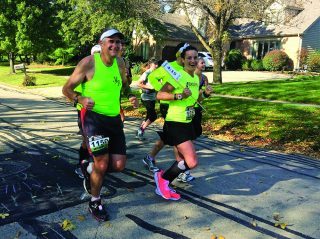
At age 30 and with a few marathons under her belt, Heather Zeigler set a goal of running 50 marathons by the time she was 50. She achieved that goal with 17 years to spare
The resident of Downers Grove, Ill., has run 157 marathons and was the 17th woman to run sub-4-hour marathons in all 50 states when she completed the Honolulu Marathon in December 2015 in 3:55:29. Two other women have joined the elite company since Zeigler’s accomplishment.
RELATED: Cancer Survivor Carol Dellinger Completes 300th Marathon in Honolulu
But for the longest time, Zeigler couldn’t stand running.
“In college [at Purdue University], I was in Navy ROTC,” Zeigler says. “We would run and I hated it. I would always be in the back of the pack.”
After giving birth to her daughter, Briyana, in 2005, Zeigler found herself overweight. She turned to running for weight management and found it wasn’t the burden it was back in college. After a short time she was running 5 or 6 miles a day, and wound up losing 45 pounds.
Zeigler was living in Florida at the time when a friend encouraged her to run in the 2007 Chicago Marathon, a race that was eventually stopped due to stifling heat. She finished the race in 4:31:42. By the time she ran Chicago again in 2009, she was back living in Illinois. Running the Fox Valley Marathon in St. Charles, Ill., the next fall took her marathon running to a higher level.
“I saw a woman wearing a shirt that read ‘52 marathons in 52 weeks,’” Zeigler remembers.
There, she made what she thought was the lofty goal of 50 marathons by age 50. Zeigler then did at least one marathon a month from November 2010 to December 2012. She once ran four marathons in a 16-day span, and ran 30 just in 2015.
Now 36, Zeigler has accomplished her running feats as a single mother.
“The question was always, ‘What do I do with my daughter?’ for long runs and races,” she says. “It has taken a toll on my family. Now that my daughter is older, she enjoys it. I bring her with. I have family that is local, which helps. And I am lucky to have family and friends who help.”
RELATED: 6 Time-Saving Tips For Busy Mother Runners
Zeigler has stayed healthy during her remarkable run. A foot injury last year is the only substantial ailment she has suffered so far.
She thought luck was on her side when she ran 3:33:33 in Spearfish, S.D., at age 33, thinking that would get her into the Boston Marathon. She missed the cut by 11 seconds. It would be 24 more races until she got her BQ; she ran Boston in 2014.
Zeigler said she is looking to limit her marathon running this year, but also admitted that “paring back” may not be the best choice of words. A friend called and got Zeigler to commit to a marathon with her in May.
“I checked my calendar and I am already doing two other marathons that month,” Zeigler says. “Maybe I don’t know what cutting back is.”
The post This Woman Has Run 157 Marathons (And She’s Not Done Yet) appeared first on Competitor.com.
A Runner’s Guide To What Not To Do On Social Media

Illustration: Michelle Schrantz
When I first joined Twitter years ago, it was a place to connect with like-minded individuals from around the globe. I was blown away by how a simple tweet could yield inspiration, information and the occasional kick in the ass from people I didn’t even know.
As a runner, it opened up a whole new world—one where I could simply @ mention my idol and she’d reply with a friendly recommendation for shoes or workouts, which is why I now tell people I am personally coached by Shalane Flanagan. (It’s not entirely a lie.) When Meb Keflezighi won the Boston Marathon in 2014, I watched it on two screens: the live TV broadcast, and on my laptop, where the rapid flow of tweets shared in my excitement that HOLY SH*T MEB IS WINNING THE BOSTON MARATHON!
Twitter was a cool place for runners back then—one where we could share in the joy of our sport, 140 characters at a time. But now? Now it’s the easiest, most direct path to telling people how much they suck.
Take, for example, a tweet I recently saw in my feed, directed at a local 5K:
“I’ll never do this race again. The weather was HORRIBLE.”
I hate running in a cold rain just as much as the next guy, but it’s not like race directors can pull a lever to make it stop. They just put on their ponchos, set up the cones at 3 a.m., and stand in the freezing rain until it’s time to take the cones down and go home to read your hate-tweets.
Or this tweet to another race:
“The hill in the final mile sucked. You really need to take that out.”
Sure. Let the race director grab a shovel and get right on that.
The worst is the entitled mini tweetstorm:
“The race starts in 15 minutes and I’m still in line for parking!”
“I can’t believe what a disorganized mess this is. #worstraceever”
“I better get my money back.”
I get it. Nothing is more stressful than a delay in getting to the start line. But scroll up a little bit, and you’ll see this same person tweeting a photo from the drive-through of a coffee shop only 20 minutes before the race start time. Before you rage-tweet, make sure it is not you who is the disorganized mess.
At some point, we realized social media was a direct line to vent our vexations and get people on board our outrage train. At that same point, we lost sight of what is truly outrageous. For a sport that’s supposed to be flooded with endorphins, runners sure are an angry bunch.
Let’s change that. When was the last time you used social media to lift someone up, not tear them down? The direct line works for that too, you know. As it turns out, 140 characters is plenty of space to pay someone a compliment.
Susan Lacke’s first book, Life’s Too Short to Go So F*cking Slow (2017, VeloPress), will be released in November.
RELATED: Don’t Even Think About Crowdfunding Your Race Costs
The post A Runner’s Guide To What Not To Do On Social Media appeared first on Competitor.com.
April 26, 2017
Gear We Love: April 2017
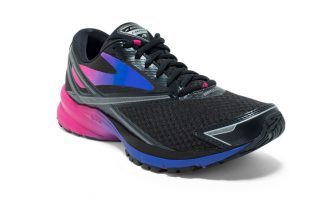
Our favorite spring gear from transitional throw-ons made for in-between weather to new shoe releases that put a little pep in our step. Check out what gear the editors are raving about this month:
RELATED: 8 Favorite Pieces Of Merino Wool Gear For Runners



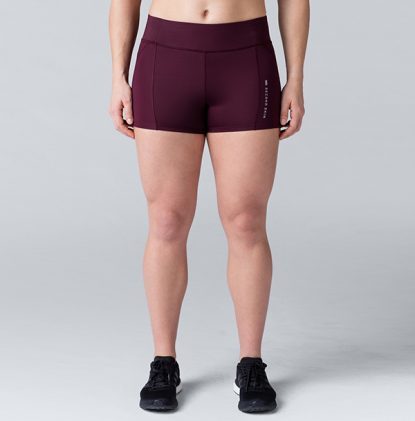
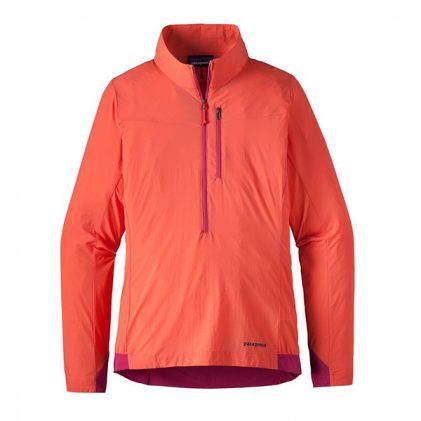


The post Gear We Love: April 2017 appeared first on Competitor.com.
April 25, 2017
Chasing Adam: Racing History In A Malaysian Paradise

Photo: Courtesy of Chapman's Race
In 1946, Freddy Spencer Chapman, a British captain and resistance fighter during World War II who had been stationed in Malaysia to fight the Japanese occupation, was caught behind enemy lines for nearly four years after the Allied forces retreated. Chapman lived and survived as a commando in the Straits of Malacca and, eventually, the jungle island Pangkor Laut. He escaped his enemies by swimming out to meet the British submarine, the HMS Statesman, in the island’s western inlet of Emerald Bay.
To commemorate Colonel Chapman’s escape, the Chapman Challenge, a run-swim event, is held on Pangkor Laut, now a 300-acre private resort paradise. The race includes 3.8 kilometers of road, 2.4 kilometers of technical trail that winds through and over a two million-year-old rainforest, and finally ends at Emerald Bay, where competitors then swim 1K and run 30 meters to the finish line at Chapman’s Bar—named after Freddy Chapman, who was decorated as a colonel after the war.
The course starts on a private road that runs past estate compounds that is normally not accessible by the resort’s guests. After about two kilometers there’s a steep climb to the first of two water stations. From there, the route dramatically descends toward the resort center, entering the jungle for the trail portion of the race. The second aid station is located at the top of another long, steep trail ascent, where the course then drops precipitously down to Emerald Bay for the run-swim transition.
The 1K swim is a horseshoe course, all within the protection of Emerald Bay, an inlet that has been awarded well-deserved accolades because of its beauty. After the swim, the finishing leg is just a quick jaunt through the white sandy beach, right at the foot of Chapman’s bar.
Chapman’s Challenge fits in well with the rising popularity of run/swim races like ÖTILLÖ. But it does so with some unique qualities, including a great history, an exotic venue, a combination of road and trail running, and incredible Malaysian hospitality, such as the beach-side foot massages offered to finishers and discounts on restorative Thai/Malay massages at the resort’s “Spa Village.” Plus, the post-race dinner extravaganza features a gourmet barbecue dinner buffet at Emerald Bay, complete with pina coladas served in whole local coconuts.
Another attraction to Pangkor Laut is the island’s incredible natural beauty and the resort’s respect for the sanctity of its surroundings. Only a small fraction of the island is developed and, even then, the structures are built around trees, rocks and other natural landmarks. The fecund ground is the natural habitat for exotic birds, bats, monitor lizards and wild boars. Other activities on the island include stand-up paddle boarding, kayaking, sailing and tennis.
RELATED: 6 Unique Destination Race Ideas for Your Next Vacation
Traveling to Pangkor Laut for Chapman’s Challenge is a rather complete vacation. But if you’re interested in extending your Malaysian vacation, here are two other places to visit: Tanjong Jara on Malaysia’s eastern coast and Malaysia’s capital Kuala Lumpur.
Get a dose of authentic Malay culture in Tanjong Jara. The snorkeling, scuba, white beaches and palm trees blend in well with the small fishing villages of the area. And, as one of the YTL properties, Tanjon Jara provides top-flight spa treatments, including a massage that incorporates flower-power medicinal properties.
In Kuala Lumpur, where you’ll most likely be entering and exiting the country, the Majestic Hotel provides a luxurious and tasteful welcome mat for the most fluid of transitions. You can enjoy the Sliano family’s smooth Malaysian jazz that harkens back to the past, as does the Colonial Café, which embellishes the tunes with its preserved and polished atmosphere. High tea is served in a very inviting Orchid Room, and the buffet offers so many choices you’ll wish you had more than one stomach.
No matter how you plan your Malaysian running adventure, though, the Chapman’s Challenge is unlike any run/swim race destination you’ll ever experience. The second annual Chapman’s Challenge will be held on May 13, 2017.
RELATED: Chasing Adam—Racking Up Miles In Hong Kong
The post Chasing Adam: Racing History In A Malaysian Paradise appeared first on Competitor.com.
Speed Development 101: Should Distance Runners Sprint?

Most runners have one big general goal: to race faster. So why do so few distance runners do speed workouts?
You might be familiar with classic workouts that many runners use in their training such as tempo runs, track intervals, hill workouts, progression runs, marathon-specific long runs. But you might be surprised to hear that none of these workouts are technically speed workouts.
Yes, they’re much faster than your easy pace and do improve your ability to race faster. However, they’re not actually “speed work.” True speed development is relatively foreign to distance runners because they are sprinter workouts, designed to improve maximal velocity, acceleration, or speed-endurance.
Let’s make sure we understand what these terms mean—so we know how to use them to make you into a faster runner.
Maximal velocity is your maximum speed. It’s how fast you can run if you try to sprint at 100 percent effort and reach your “top-end” speed.
It’s helpful to know that even Usain Bolt, the fastest sprinter of all time, can only maintain maximal velocity for about 30 to 50 meters (more on this below).
Acceleration is how quickly you can go from a position of rest to maximal velocity. Essentially, it’s about the rate of increasing speed and it’s also a good measure of how much power you can generate.
Speed-endurance is how long you can maintain your maximal velocity. Since most of us can only maintain our maximal velocity for about 5 to 7 seconds, even big improvements on this aspect of speed won’t translate to significant performance improvements for distance runners.
For the most part, these three elements of speed aren’t the “big wins” that runners should focus on. After all, you never approach your maximal velocity or try to accelerate as fast as possible in any race from the mile on up.
Still, a small dose of speed development work in your training can pay large dividends.
Should Distance Runners Focus on Speed Development?
There are three main reasons why runners should incorporate speed development in their training.
First, it improves top-end speed. You’ll be able to sprint faster, thus increasing the range of speed that you’re capable of achieving.
This helps slower paces feel a lot easier. And if you compete in middle distance events like the 800m, mile, or 3,000m then you’ll experience tangible performance improvement.
RELATED: How To Develop Speed For A Fast 5K
Second, sprinting forces your legs to recruit more muscle fibers to increase its power production. By having a larger pool of fibers available, you’ll be able to sprint more effectively at the end of a race.
Finally, those speed development workouts will improve your running economy—or, rather, your efficiency. All those extra muscle fibers are now available when you’re tired, running uphill, or finishing a long run. Essentially, you have a larger pool of muscle to draw from when you’re fatigued or trying to run hard at the end of a race.
Sprinting also reinforces proper running form, further enhancing your running economy. After all, it’s much more difficult to run with sloppy form when you’re at maximal velocity.
How to Add Speed Work To Your Training
Speed development work is very challenging—not because there’s a lot of volume at fast paces or the rest is short, but because it stresses the central nervous system.
These sessions are neuromuscular, challenging the communication pathways between the brain and muscles. They require a long recovery interval and a low volume of total work. While a speed development workout may not look like a “hard workout” it will most certainly leave you quite sore after your first session.
Since they’re so difficult, it’s best to run these workouts when you’re fresh at the beginning of a workout.
After a series of dynamic warm-up exercises, some easy running, and strides, you can add several short repetitions before the main part of your workout.
Here are a few examples, with each one getting progressively more difficult:
4 x 8sec hill sprints, 60-90sec walk recovery
4 x 20m, 90sec – 2min walk recovery
6 x 25m, 2min – 2:30 walk recovery
6 x 30m, 2min – 2:30 walk recovery
The two most important things to remember about speed development for distance runners is that a small amount is all that’s necessary and you need to run as fast as possible. There’s no need to run a high number of repetitions at maximum speed.
In fact, doing so only predisposes you to a higher risk of injury. When in doubt, run fewer repetitions with longer recoveries. Play it safe!
RELATED: Speed Workouts You Can Do Anywhere
Doing one of these workouts per week is all that’s needed to gain the power, efficiency, and speed benefits. They’re not a focus, but rather a supplemental training tool that’s available to work on an oft-neglected area of fitness for distance runners.
After 4 to 6 weeks of consistent sprint work, done in a gradual and safe way, runners are going to start feeling faster and more powerful than before.
Soon, those benefits will transfer to the longer distances and you’ll have a shiny new personal best to show for all your hard work!
* * *
About the Author:
Jason Fitzgerald is the head coach at Strength Running, one of the web’s largest coaching sites for runners. He is a 2:39 marathoner, USATF-certified coach and his passion is helping runners set monster personal bests. Follow him on Twitter @JasonFitz1 and Facebook.
The post Speed Development 101: Should Distance Runners Sprint? appeared first on Competitor.com.
Mizuno Releases Patriotic Limited Edition Shoe For Peachtree Road Race
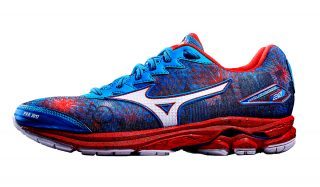
 Photo: Courtesy of Mizuno
Photo: Courtesy of Mizuno
If you’re running this year’s AJC Peachtree Road Race, then you’ll want to get your hands on a pair of their customized shoes created by Mizuno. The Limited Edition Peachtree Wave Rider 20 features an outline of the Atlanta skyline, a Georgia peach and fireworks to commemorate the world’s largest 10K that takes place on Independence Day.
According to Mizuno running brand manager Chris Hollis, the inspiration for the design came from the tradition of the AJC Peachtree Road Race occurring on Fourth of July every year. Hence, the red, white and blue colorway with fireworks over a skyline inspired by the race course itself, which begins at Lenox Square, goes across Buckhead, through Midtwon and down 10th Street to the finish line at Piedmont Park. There’s even an official AJC Peachtree Road Race logo on the shoe tongue.
 Photo: Courtesy of Mizuno
Photo: Courtesy of Mizuno
The Wave Rider 20 is also Mizuno’s longest-standing running shoe featuring new cloudwave technology that provides runners with that smooth wave-like heel-to-toe transition. This will be the second year that Mizuno has created a customized shoe for the race.
With only 3,000 pairs available that means just 5 percent of the 60,000 race participants will be able to snag a pair of these patriotic kicks on sale for $130. Here’s a breakdown of where and when you can get a pair:
April 21: Pre-sale begins at Big Peach Running Co.
May 1: Additional pre-sale begins at other specialty retailers
June 1: Shoes officially in market at Big Peach Running Co. and other specialty retailers, including the Mizuno Experience Center at SunTrust Park and mizunousa.com
Expo: Mizuno will be saving some pairs for registered AJC Peachtree Road Race runners who attend the Expo.
The post Mizuno Releases Patriotic Limited Edition Shoe For Peachtree Road Race appeared first on Competitor.com.
April 24, 2017
Mary Keitany Breaks All-Women’s World Record At London Marathon
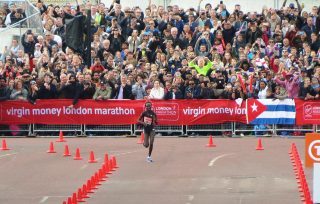
Mary Keitany with 200 meters to go in the 2017 Virgin Money London Marathon. Photo: Jane Monti for Race Results Weekly
(c) 2017 Race Results Weekly, all rights reserved.
Kenya’s Mary Keitany threw caution to the wind here today. She blasted through the first half of the 37th Virgin Money London Marathon in a scorching 1:06:54, and held on to finish alone on The Mall in 2:17:01, the pending IAAF world record for an all-women’s marathon. Her performance broke Paula Radcliffe’s previous all-women’s mark of 2:17:42 set in 2005 by 41 seconds (Radcliffe’s 2:15:25 time set in 2003 still stands as the women’s world record in the marathon in a mixed gender race due to male pace-makers that day). Keitany’s time is also the second fastest women’s marathon of all-time in a mixed gender race.
“I want to say it was a great day for me,” said the tiny 35-year-old mother of two who has won the last three editions of the TCS New York City Marathon.”It was really amazing.”
It was also very lucrative. Not considering her appearance fee or any unpublished bonuses from either the race organizers or her sponsor, adidas, Keitany earned $305,000 in prize money and time bonuses: $55,000 for the win, $100,000 for sub-2:18, $25,000 for the course record and $125,000 for the world record.
“I’m really excited about my great time that I did today,” she told reporters.
Keitany made her intentions known very early in the race. After a quick and potentially sustainable 5:15 first mile, she and pacemaker Caroline Chepkoech surged ahead, running the second mile in 5:09 then the third (downhill) mile in a head-snapping 4:37. The duo cleared 5K in a sizzling 15:31, and the record attempt was on.
“It was inside world record pace,” Keitany said. “I was prepared for any pace as I was preparing.”
With the rest of the women out of sight and out of mind, Keitany and Chepkoech concentrated on the task at hand. Wearing an all-black kit, Keitany hit 10K in 31:17 (15:46), 15K in 47:15 (15:58) and 20K in 1:03:26 (16:11), all personal bests for her pacemaker, Chepkoech. Her arm warmers came off about 10 miles into the race as Keitany’s brow began to glisten with sweat.
Chepkoech set another PB of 1:06:53 at the half-marathon point with Keitany one second behind. The pair were well up on Paula Radcliffe’s halfway split of 1:08:02 from her absolute world record run of 2:15:25 set here in 2003.
Soon, the pacemaker stepped off leaving Keitany all alone on a sub-2:14 pace with only the chants of the crowds to help her.
“After the pacemaker dropped out, I just went alone to the finish line,” Keitany said matter-of-factly.
In the past, Keitany has made a bold first half run which ended poorly. In the 2011 New York City Marathon, she ran 1:07:56 for the first half and faded badly to finish third, passed by Ethiopians Firehiwot Dado and Buzunesh Deba in Central Park. However, she was determined not to let that happen in London.
“I was ready today,” Keitany said when asked about that fateful race in New York, a course she would ultimately master. “If somebody is following me I can still push. I was ready.”
The kilometers passed, and the sun came out making things just a bit warmer. Keitany’s pace was slipping, but it wasn’t collapsing. She ran the 5K through 25K in, 16:17 then the next two 5K blocks in 16:22 and 16:34. She smashed the 30K world record by two minutes, clocking 1:36:05 at that point, and had built-up a 75-second lead over second and third place Tirunesh Dibaba and Helah Kiprop, the only women who remained within striking distance.
“She’s not falling apart; she’s still running,” observed Paula Radcliffe on the BBC broadcast.
Keitany slowed a bit more in the last 5K segment through 40K to 16:59, but she had already locked down the record and put the race out of reach. Dibaba was suffering from stomach distress and had stopped and vomited around the 30K mark. The Ethiopian then gathered herself and went on to finish second in an excellent 2:17:56, making her the third-fastest woman of all time.
“This is my second marathon as you all know,” Dibaba said in the post-race press conference. “Yes, I have recorded a fast time, a personal best. I am satisfied with the results.”
The always consistent Aselefech Mergia, who won this race in 2010, passed Kiprop before 40K to clinch third place in 2:23:08. Vivian Cheruiyot, in her debut, finished fourth in 2:23:50, followed by Australia’s Lisa Weightman (2:25:15 PB) and America’s Laura Thweatt (2:25:38 PB). Kiprop faded badly in the final seven kilometers to finish seventh in 2:25:59.
“Just sheer will,” said Thweatt of what carried her through the second half when she was hurting. “It was just one of those days in the marathon when it all comes together. I got into a rhythm and was just able to keep it.”
In the battle among British women for World Championships selection and the British national title, Aly Dixon (14th in 2:29:06 PB) and Charlotte Purdue (15th in 2:29:23 PB) clinched team berths (Dixon also retained her national title). Five-time Olympian Jo Pavey was forced to drop out. She recorded her last split of 1:29:09 at 25K.
The post Mary Keitany Breaks All-Women’s World Record At London Marathon appeared first on Competitor.com.
April 21, 2017
American Elites Ready For London Marathon Debuts
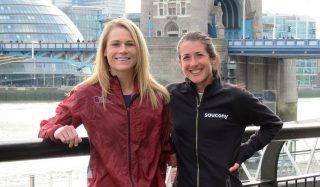
Kellyn Taylor (left) and Laura Thweatt pose in front of The Thames three days before the 2017 Virgin Money London Marathon. Photo: Jane Monti for Race Results Weekly
(c) 2017 Race Results Weekly, all rights reserved
Sunday’s 37th Virgin Money London Marathon has a power-packed elite field of 35 men and 30 women, but only two are from the United States: Kellyn Taylor, 30, of Flagstaff, Ariz., and Laura Thweatt, 28, of Superior, Colo. Both women will be running their first marathons outside of the U.S., and after spending more than a week in Britain to adjust to the time zone and climate, they said yesterday that they are excited and ready to run.
“My build-up was good,” said Taylor, who has a personal best of 2:28:40 and runs for the Hoka One One Northern Arizona Elite squad coached by Ben Rosario. “I feel prepared.”
Thweatt, who made a successful marathon debut at the 2015 New York Marathon with a time of 2:28:23 and is coached by three-time Australian Olympian Lee Troop, agreed.
“It was both Lee and my decision (to run London),” said the Saucony-sponsored athlete. He asked me what the next marathon I wanted to do in the spring coming off of the Olympic year. I had never been to London.”
Both women have had long breaks since their last marathons. For Taylor, London will be her first 42K race since she finished sixth at the U.S. Olympic Trials Marathon in Los Angles in February of 2016. In that hot and sunny race, Taylor pressed the pace early and was still in contention for the podium past the halfway point (she was only one second behind eventual second place finisher Des Linden at 25K). But she faded in the second half, wilting in the heat.
“With an Olympic year there are so many ups and downs,” said Taylor, who would later finish fourth at the U.S. Olympic Trials in the 10,000m, missing a team spot by just one place. “You have a lot of emotion coming off of that.”
Taylor had planned to run last November’s TCS New York City Marathon, but was forced to scratch in September after not hitting her workouts and feeling persistently fatigued. Looking back, she now sees that as a blessing, allowing her to completely rest and regroup and be ready to run in the spring.
“Unfortunately, New York didn’t happen, but it ended up being a blessing in disguise,” said Taylor, who grew up in Wisconsin. “I got do so some other things that I enjoyed… to be excited about this year.”
RELATED: Women’s World Record Could Be Broken At This Year’s London Marathon
After her successful debut in New York, Thweatt struggled to find her best form in 2016, hampered by a painful injury called osteitis pubis, an inflammation of the pubic symphysis and surrounding muscle insertions. It’s a condition which will only fully resolves with total rest, but Thweatt and her therapists have been trying to manage it so she can keep training.
“She’s been battling with osteitis pubis,” explained Troop, who has run the London Marathon three times. “She was struggling to get the injury under control and take the next step. She’s 95 percent healthy.”
Unlike Taylor, Thweatt chose to pass on the U.S. Olympic Trials Marathon so she could focus on the track. She chose to double at the U.S. Olympic Trials in the 5000m and 10,000m, but was knocked out of the shorter race when she only finished eighth in her heat, and finished one place behind Taylor (5th) in the longer race. She took a long break after that and only ran one road race in the fall.
“It just sort of got worse,” said Troop of Thweatt’s condition last summer. “It’s the Olympic Trials so you keep pushing it. She’d be trying to do workouts and would be in pain and crying.”
Neither woman would share their specific race plans for Sunday, but both said they were looking forward to having good races and saw personal best times as a good possibility on London’s mostly flat course. In addition, both women have the full support of their families attending the race. Taylor’s parents, Tom and Katie Johnson, are here along with her husband, Kyle, and 6-year-old daughter Kylyn.
Thweatt’s parents, Steve and Jean, are also in London, and her fiancé, Matt Hensley, arrives today. Even Thweatt’s 85-year-old grandmother, Eunice, has come to London from Eugene, Ore., a trip which Thweatt said required five flight segments. “She’s resting now,” said Thweatt at a dinner last night near her hotel.
Only one American woman, Deena Kastor, has won the Virgin Money London Marathon. In 2006, she ran the absolute American record of 2:19:36 and remains the only American woman to break 2:20.
The post American Elites Ready For London Marathon Debuts appeared first on Competitor.com.
Is Running Good For The Planet? Many Events Are Going Green

With all the sweat and fresh air, running certainly feels like a healthy activity. Good for you? Of course. Good for the planet? Well, that depends. Especially when you consider the environmental impact of races with thousands upon thousands of people adding litter and traffic to city streets or wild trails. From paper registration forms and single use cups, to leftover food and the impact of people traveling to events, races can be significant environmental stressors. The good news: there is room for improvement, with many major events already making significant changes.
Going Cupless
Reducing trash through recycling and reusing items is a visible area for improvement at events. Race course aid stations littered ankle deep in cups, as volunteers manically attempt to keep up with the ever-growing pile of refuse, is an all too common race day sight. In 2013, the Chuckanut 50K was one of the first races in the U.S. to go cupless.
“As trail runners, we are completely sustainable running through the mountains, so my thought was ‘why do we need cups at an event?’” says Krissy Moehl, Chuckanut 50K race director. “I already had people bringing bowls for post-race soup, so it made sense. The first year I provided cups for people to buy, after that they got the idea.”
The cup Moehl offered for sale was the original reusable C2 cup from UltrAspire, created out of conversations from an athlete summit the brand hosted. Moehl now works with Ultimate Direction, but was an UltrAspire athlete at the time.
“The idea for the cup came from Roch Horton, long time ultra running legend. He volunteers at aid stations in many prominent races and sometimes the aid stations are in remote places,” says UltrAspire owner Bryce Thatcher.“I knew something needed to be done to help with this. Interestingly enough, this is the same reason we developed the first gel bottle, to keep gel wrappers off the trail.”
RELATED: 5 Ways To Be A More Sustainable Runner
Now Moehl partners with Sustainable Connections of Bellingham, Wash., for the Chuckanut 50K to ensure the race is as environmentally friendly as possible. From a race shirt you get only if you specifically order it, to food trucks serving food in compostable dishes and sustainable awards, Moehl is setting a blazing example. Corralling the trash was a recent hurdle.
“Last year our garbage bin was completely full because bags coming back from aid stations weren’t sorted. Doing it after the fact wasn’t fun,” Moehl says. “We now provide separate bags for recycling, compostables and trash. We also implemented a ‘King’ and ‘Queen’ of trash who help with the sorting process. This is something we definitely learned the hard way!”
HydraPak also has a reusable cup, something they created for similar reasons to UltrAspire.
“We designed the Speed Cup when we saw how much waste was being generated at aid stations during races,” says Morgan Makowski from HydraPak. “There are always garbage bins full of paper cups and for larger road races, the pavement is littered with cups.”
Runners are required to carry reusable cups or refillable containers at all the races of the Ultra-Trail du Mont-Blanc as well. Savvy UTMB aid station volunteers also use the cut off bottom of empty soda bottles as reusable cups for runners who are too tired to find theirs.
Certified Races
Navigating the process can mean an extra long to-do list for race directors. But now there are certification organizations, like the Council for Responsible Sport and Athletes For a Fit Planet, to help.
The Council for Responsible Sport was launched in 2007 to “support, certify and celebrate responsibly produced sports events.” Their certification process is rigorous, making it all the more impactful when events are recognized. The end goal is to increase an event’s “social benefits while reducing its environmental impact.” The Chicago, Los Angeles, Marine Corps, Austin, Flying Pig, Eugene and Hartford Marathons, Vancouver Half Marathon, Beach to Beacon 10K and U.S. Olympic Track & Field Trials are just some of the events that have recently received ReSport Certification. Chicago is the largest marathon to be certified.
Several Ragnar races have also received ReSport Certification. Now the Ragnar Trail Series is partnering with Klean Kanteen to reduce environmental impact and waste at events and educate runners about reusables. Ragnar Trail Races are already cupless events, meaning no disposable cups are offered in the race venue. Education and awareness are the next step.
“Single use waste is prevalent in the world of human powered races. There is a lot of potential for improvement around how races handle on-course water stations and the disposable cup waste they produce,” says Melissa McClary of Klean Kanteen. “It is our end goal to help shift the paradigm around what racers expect from the events they participate in terms sustainability measures.”
Reusing Race Swag
Clothes are also an issue. From race shirts, that may or may not be worn again, to the endless mountains of clothes dropped at the start line and along the course, races are finding viable solutions. Many races, like the Chuckanut 50K and Bolder Boulder 10K, give runners the choice to opt out of a shirt or donate it to a good cause. Other events offer organic cotton shirts or shirts made completely of recycled polyester. Some races have found charitable solutions for clothes left along the race course. Ten tons of clothing was collected from the start line of the 2016 Chicago Marathon and donated to the Pacific Garden Mission and Illinois Amvets. While the New York City Marathon has donated 166,050 pounds of discarded clothing to Goodwill in 2016.
RELATED: Adidas Makes Running Shoes From Recycled Ocean Plastic
When feeding runners, the last thing races want to do is to run out of food, meaning there will be leftovers. Much of that used to end up in landfills. The Chicago Marathon donated 17 tons of food and water to the Greater Chicago Food Depository after the 2016 event. The 2016 New York City Marathon donated 19,000 pounds of unused food to area homeless shelters, a positive trend being implemented at other races. Much like the discarded clothing, tons of waste is kept from landfills, and is used to help those in need. These actions build the social benefits and reach of running events.
As for racer goody bags, often plastic bags filled with a stack of paper inserts, those are getting better too. Many now distribute reusable bags. Other races have switched to virtual goody bags, meaning all special offers can be found online. Instead of a medal, the Bolder Boulder 10K gives every finisher a reusable lunch bag.
Other social impacts include creative initiatives such as required volunteering. The Western States Endurance Run requires eight volunteer hours of trail work or at a running event for each runner. Both the Chicago and Hartford Marathons plant trees to offset their environmental impact. Whether you agree with the concept or not, the Chicago Marathon also purchased Green E-Climate certified offsets to help with the impact of the Marathon’s carbon footprint.
There is still a long way to go. But these are encouraging signs. Both road and trail races are making environmentally friendly changes. Companies and brands are working together for smart solutions. Even participants are taking responsibility for their race day decisions—carpooling and using public transportation for the win. The future of racing is looking green indeed.
The post Is Running Good For The Planet? Many Events Are Going Green appeared first on Competitor.com.
Olympic Gold Medalist Brianna Rollins Suspended For Missed Drug Test

Brianna Rollins won gold in the 100 meters at the 2016 Rio Olympic Games. Photo: Photorun.net
Brianna Rollins, gold medalist in the 100 meters in Rio 2016, has been banned from track and field for one year due to three missed drug tests. Her 12-month suspension began on Dec, 18, 2016 and will run until Dec. 17, 2017. She will miss the entire 2017 outdoor season.
Rollins never tried to evade testing. When athletes are out of competition, they have to use a computer program to register their whereabouts at all times. Confusion with the computer program caused her to inadvertently list her whereabouts incorrectly.
In a statement, Rollins accepted the suspension. “I accept full responsibility for the mistakes that have led to my suspension, and am disappointed that I will have to miss this coming outdoor season, as a result of my confusion over how the whereabouts program worked. I have always been and continue to be a supporter of USADA and their fight to keep our sport clean, and I will continue to do my part to prove that success can be achieved without taking any shortcuts.”
Rollins had been tested 16 times in 2016 and has never failed a test or had a suspicious result. However under the World Anti-Doping Agency code, three failures results in a violation.
RELATED: Turkish Runners Banned For Doping
The post Olympic Gold Medalist Brianna Rollins Suspended For Missed Drug Test appeared first on Competitor.com.
Ryan Hall's Blog
- Ryan Hall's profile
- 21 followers



